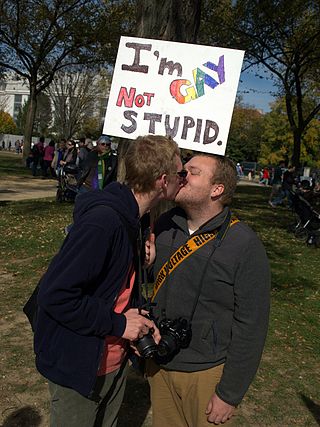Gender-neutral language is language that avoids assumptions about the social gender or biological sex of people referred to in speech or writing. In contrast to most other Indo-European languages, English does not retain grammatical gender and most of its nouns, adjectives and pronouns are therefore not gender-specific. In most other Indo-European languages, nouns are grammatically masculine or grammatically feminine, or sometimes grammatically neuter, regardless of the actual gender of the referent.
A third-person pronoun is a pronoun that refers to an entity other than the speaker or listener. Some languages with gender-specific pronouns have them as part of a grammatical gender system, a system of agreement where most or all nouns have a value for this grammatical category. A few languages with gender-specific pronouns, such as English, Afrikaans, Defaka, Khmu, Malayalam, Tamil, and Yazgulyam, lack grammatical gender; in such languages, gender usually adheres to "natural gender", which is often based on biological sex. Other languages, including most Austronesian languages, lack gender distinctions in personal pronouns entirely, as well as any system of grammatical gender.
Femme is a term traditionally used to describe a lesbian woman who exhibits a feminine identity or gender presentation. While commonly viewed as a lesbian term, alternate meanings of the word also exist with some non-lesbian individuals using the word, notably some gay men and bisexuals. Some non-binary and transgender individuals also identify as lesbians using this term.

Non-binary and genderqueer are umbrella terms for gender identities that are outside the male/female gender binary. Non-binary identities often fall under the transgender umbrella since non-binary people typically identify with a gender that is different from the sex assigned to them at birth, although some non-binary people do not consider themselves transgender.
Shemale is a term most commonly used in the pornography industry to describe trans women or other people with male genitalia and female secondary sex characteristics acquired via hormones or surgery. Many people in the transgender community consider the term offensive and degrading. Using the term shemale for a trans woman may imply that she is working in the sex trade.

A trans man is a man who was assigned female at birth. Trans men have a male gender identity, and many trans men undergo medical and social transition to alter their appearance in a way that aligns with their gender identity or alleviates gender dysphoria.
A possessive or ktetic form is a word or grammatical construction indicating a relationship of possession in a broad sense. This can include strict ownership, or a number of other types of relation to a greater or lesser degree analogous to it.

Terms used to describe homosexuality have gone through many changes since the emergence of the first terms in the mid-19th century. In English, some terms in widespread use have been sodomite, Achillean, Sapphic, Uranian, homophile, lesbian, gay, effeminate, queer, homoaffective, and same-gender attracted. Some of these words are specific to women, some to men, and some can be used of either. Gay people may also be identified under the umbrella term LGBT.
Boi is slang within butch and femme and gay male communities for several sexual or gender identities.
Personal pronouns are pronouns that are associated primarily with a particular grammatical person – first person, second person, or third person. Personal pronouns may also take different forms depending on number, grammatical or natural gender, case, and formality. The term "personal" is used here purely to signify the grammatical sense; personal pronouns are not limited to people and can also refer to animals and objects.

Androphilia and gynephilia are terms used in behavioral science to describe sexual orientation, as an alternative to a gender binary homosexual and heterosexual conceptualization. Androphilia describes sexual attraction to men and/or masculinity; gynephilia describes the sexual attraction to women and/or femininity. Ambiphilia describes the combination of both androphilia and gynephilia in a given individual, or bisexuality.
The gender binary is the classification of gender into two distinct forms of masculine and feminine, whether by social system, cultural belief, or both simultaneously. Most cultures use a gender binary, having two genders.
Gay is a term that primarily refers to a homosexual person or the trait of being homosexual. The term originally meant 'carefree', 'cheerful', or 'bright and showy'.
Gender-neutral language or gender-inclusive language is language that avoids reference towards a particular sex or gender. In English, this includes use of nouns that are not gender-specific to refer to roles or professions, formation of phrases in a coequal manner, and discontinuing the collective use of male or female terms. For example, the words policeman and stewardess are gender-specific job titles; the corresponding gender-neutral terms are police officer and flight attendant. Other gender-specific terms, such as actor and actress, may be replaced by the originally male term; for example, actor used regardless of gender. Some terms, such as chairman, that contain the component -man but have traditionally been used to refer to persons regardless of sex are now seen by some as gender-specific. An example of forming phrases in a coequal manner would be using husband and wife instead of man and wife. Examples of discontinuing the collective use of terms in English when referring to those with unknown or indeterminate gender as singular they, and using humans, people, or humankind, instead of man or mankind.

Gender neutrality in languages with grammatical gender is the usage of wording that is balanced in its treatment of the genders in a non-grammatical sense. For example, advocates of gender-neutral language challenge the traditional use of masculine nouns and pronouns when referring to two or more genders or to a person of an unknown gender in most Indo-European and Afro-Asiatic languages. This stance is often inspired by feminist ideas about gender equality. Gender neutrality is also used colloquially when one wishes to be inclusive of people who identify as non-binary genders or as genderless.
A genderless language is a natural or constructed language that has no distinctions of grammatical gender—that is, no categories requiring morphological agreement between nouns and associated pronouns, adjectives, articles, or verbs.
LGBT linguistics is the study of language as used by members of LGBT communities. Related or synonymous terms include lavender linguistics, advanced by William Leap in the 1990s, which "encompass[es] a wide range of everyday language practices" in LGBT communities, and queer linguistics, which refers to the linguistic analysis concerning the effect of heteronormativity on expressing sexual identity through language. The former term derives from the longtime association of the color lavender with LGBT communities. "Language", in this context, may refer to any aspect of spoken or written linguistic practices, including speech patterns and pronunciation, use of certain vocabulary, and, in a few cases, an elaborate alternative lexicon such as Polari.
Queer heterosexuality is heterosexual practice or identity that is also controversially called queer. "Queer heterosexuality" is argued to consist of heterosexual, cisgender, and allosexual persons who show nontraditional gender expressions, or who adopt gender roles that differ from the hegemonic masculinity and femininity of their particular culture.
The Handbook of Nonsexist Writing: For writers, editors, and speakers was first published in 1980 by Casey Miller and Kate Swift. It was the second book produced by the two in an effort to raise awareness of issues concerning gender in the English language.
Feminist language reform or feminist language planning refers to the effort, often of political and grassroots movements, to change how language is used to gender people, activities and ideas on an individual and societal level. This initiative has been adopted in countries such as Sweden, Switzerland and Australia.




